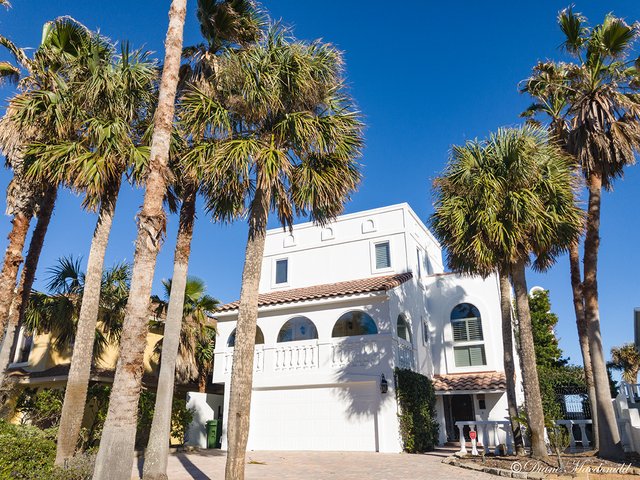Photography101 – Whiteiswhite – Iphone 8 Plus - Original Photography – Shooting in Raw Format
USING RAW FORMAT ON AN IPHONE 8 PLUS
Don't let that blue sky deceive you! Here in North Florida, it was barely above freezing and the wind from the ocean was bitingly cold yesterday when I took this shot of a white house along the beachfront in Jacksonville Beach !

Image © Diane Macdonald. All Rights Reserved.
Camera: iPhone 8 Plus
Post Processing: Adobe® Camera Raw and Adobe® Photoshop CC 2017
When I photograph with my Canon 5D Mark II (my DSLR camera), I always shoot in raw format. Doing so preserves all the information that the camera sees and records it on the sensor. When you shoot in jpeg format, that information is compressed, and the information that is lost can't be recovered. Shooting in raw gives you much higher quality images that you can adjust to your liking without destroying information, whereas when you shoot in jpeg format the camera does the processing from raw for you and decides which information to keep and which to throw away!
Everything you use is going to have a pro and a con argument, and using raw mode is no different. Here then are some of the pros to using raw:
A big plus for using raw, is that editing is non destructive. That means that you never change the original raw file, so you can make as many changes to it as often you like, saving the results in jpeg or TIFF, depending on whether you want to do further processing. Saving in jpeg would be for an image that is the end result, because every time you save a jpeg file after making changes, you throw away information, losing image quality each time!
Jpeg files record only 256 levels of brightness and color tones, whereas raw files record between 4,096 and 16,384 levels depending on the bit depth used (12, 14 or 16!) So, the numbers alone for even 12 bit should show you how much wiggle room you have for making adjustments to an image!
It is always better to get the exposure right with the camera, but if you happen to make a mistake and capture a great shot that is either over or under exposed, with camera raw you can make corrections without seriously affecting the quality!
Jpeg files add camera sharpening to the image, but with raw you have much more control over sharpening and detail depending on the output of your photograph.
Another thing that raw is good for is correcting white balance after the image has been shot. You have way more information to work with, although the white balance has already been recorded. When you shoot in jpeg, the white balance is added to the shot and without better details to work with, making changes does not have good results.
Of course, there are also drawbacks to shooting in raw mode, so here are some cons:
The images need processing! Think of them as film was in the old days. If you were doing it yourself, you needed to work in a darkroom with the film in order to get an end result. Raw images in a similar way need to be processed in either Adobe® Photoshop or Lightroom or a special app on a smartphone.
Raw images are much larger, so they take up more room on your computer, smartphone, SD or CF cards!
Shooting in raw slows down the camera's buffer, so it is not recommended for fast action shots, like in sports photography, although it can be used.
Even if you use a point and shoot camera, it may be possible for you to take advantage of shooting in raw. Check your camera's manual!
But did you know that you can shoot in raw with your iPhone while using a third party app? I photographed today's image for the whiteiswhite challenge in an app called Camera+ on my new iPhone 8 Plus. I could have made the adjustments to the raw file right in the app, but I always download my images to my computer where I can work on them in Adobe® Camera Raw an Adobe® Photoshop, so that is what I did! I also resized the image to 72 dpi for web viewing before uploading.
If you have questions, please don't hesitate to ask! I love to share information! Another time I will write a post about using Camera+, which I have used for a long time, so look out for that post shortly!
xxxxxxxxxxxxxxxxxxxx
Whiteiswhite Challenge:
Monday: White Photographed Against White
Tuesday: Animals
Wednesday: Flowers
Thursday: Food And Drink
Friday: Architecture
Saturday: Water In Nature
Sunday: Anything Goes
xxxxxxxxxxxxxxxxxxxx
If you are entering the wiwcontest, please read the rules on this winners announcement post, and UPVOTE it to make sure your entries are eligible!
xxxxxxxxxxxxxxxxxxxx
Thanks for taking the time to read this! I appreciate it. Please check out my photography-101 account here: https://steemit.com/@photography-101 and Follow if you wish. Shortly I will be making all my Photography101 posts from there!



Sneaky Ninja Attack! You have been defended with a 0.73% vote... I was summoned by @dmcamera! I have done their bidding and now I will vanish...Whoosh
That's cool! Thanks!
This is awesome my dear friend! Thank you very much for the tips! Congratulations
I hope it helps! If you check out the link I have at the end, you will see the past posts I made that may be helpful to you.
A good friend of mine introduced me to the Camera+ app a few years ago. I've been a fan ever since. I alternate between that and Afterlight to edit my iPhone photos. I'm glad to see you having so much fun with your 8 Plus! My upgrade is happening in a few weeks. I'm still deciding between the 8 Plus and the X.
And it's so funny how cold weather doesn't translate in places like FL and CA. You'd never know!
Hi Diane, thank you for posting some information along with your photo. I am currently using an iPhone 7 plus and the most recent version of the camera+ plus app. It wasn't until a few days ago I found out that I can save RAW format which brought a smile to my face. The drawback is that as far as I know, I can only use it while using one "faux" lens setting. Is that the same when using a full body DSLR Camera? One of the reason's why I am asking that is because while going through the learning process, I think I might want to purchase one in a few months only because I know that due to the limitations that a smartphone has, I might find myself getting bored, losing interest, and losing skills ....again. Practicing photography is much like exercising, or so I think. I just started reading through your photography101 account along with a few gem websites that I have found. One site has articles about the theory of depth of field which is something that I never studied, but would like to learn the theory of also. I hope that by learning theory, it might help me make a more informed decision on the types of lenses that I will purchase. I'd like to add that I think it is important to views photographs that have been made by long time hobbyist's and professional's because by doing so, it help train my mind to see differently. Some people are just happy enough to snap decent photo's of their moment's without the desire to bring it to the next level and I think that there is nothing wrong about that, we all have different goals. I would like to take it a few levels further and by reading your account photography 101 along with other gems, and practice practice practice, I hope to kick it up to several levels higher. I still have my old 35 mm SLR film camera's, one goes back to my high school days and signed up for a high school photography course, I did ok, I think I earned a B+ or maybe an A-. Fun times!
Thanks for your very detailed comment. I'm not sure what you mean about a "faux" lens setting, but of course the smartphone will have its drawbacks over a DSLR. You are stuck with a fixed phone lens and the sensor is a lot smaller. With a DSLR, you can use any lens you want. Raw is captured always anyway. It's just that if you choose jpeg, you are telling the camera to decide which detail to throw away. If you use raw, then you arein control. If you are serious about photography and want to be in control of depth of field and resulting bokeh, then by all means buy a DSLR, so that you can control f-stops.
But an app like 645 Pro for the Phone allows you set the speed and fstops in the app. If you want to be taking proper zoomed or macro images, a DSLR with interchangeable lenses is a must. However, if you just want to have fun with your photography while learning along the way, an Phone is fine! It is better quality than my first DSLR! I shoot professionally with my Canon 5D Mark II and also with my iPhone!!